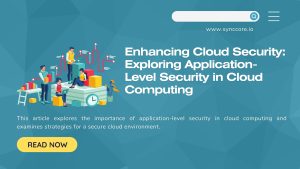The cloud revolution has begun. In 2022, 61% of businesses migrated their data to the cloud, and cloud spending is now expected to reach 14% of total IT spending by 2024.
Cloud services assist businesses in streamlining workflows and reducing their reliance on inefficient on-premises infrastructure. By “air gapping” critical data and keeping it off-premises, data can be protected in the cloud and separated from user workstations.
Regardless of cloud adoption, 67% of businesses anticipate a data breach within a year. In short, neither cloud nor on-premises data is secure, as demonstrated by DropBox, which recently advised users to keep additional backups if their cloud is hacked. Data loss can be disastrous for businesses that must develop a solid disaster recovery (DR) plan.
That is why we will look at some of the best practices for disaster recovery to the cloud today. Let’s get this party started.
Table of Contents
What is Cloud Disaster Recovery?
Business systems frequently rely on both local and cloud infrastructure to function correctly. A company will most likely experience costly downtime, reputational damage, and data loss if either is damaged.
Cloud disaster recovery safeguards businesses in a variety of scenarios, including:
Human Errors: Human error accounts for an astounding 88% of cloud breaches. Inadequate password security, connecting to services via insecure public networks, and poor IT hygiene can all lead to the exposure of local and cloud data.
Natural Disasters: Flooding, fires, earthquakes, hurricanes, tornadoes, and other natural disasters can all cause infrastructure damage. After being damaged by a natural disaster, 40% of SMBs never reopen.
Technical Failures: CDR safeguards against catastrophic technical failure caused by internal or external factors such as power surges, short circuits, and damage caused by faulty repairs and installations.
Threat Actors: Both internal and external threat actors can leak account and password information. Attacks such as spear phishing, brute force, and modern ransomware can expose local and cloud data.
The Importance of Cloud Disaster Recovery
According to Gartner, network downtime at the enterprise level can cost up to $5,600 per minute, while 60% of small businesses fail within six months of being hacked.
Catastrophic data loss causes reputational as well as financial harm. Many jurisdictions require businesses to contact customers and clients to notify them if their data is lost. This can result in large compensation payouts and criminal charges. The Federal Trade Commission, for example, fined Facebook $5 billion for failing to notify 530 million users of a data breach.

Cloud Disaster Recovery Best Practices
Cloud disaster recovery is more complicated than simply scheduling regular data backups and restoring lost data into systems and applications. Indeed, 60% of cloud backups are incomplete, with 50% failing.
Businesses can avoid becoming statistics by incorporating some of the best practices listed below into their cloud disaster recovery strategy.
1. Find the Right Provider
Most business infrastructure will be supported by a skilled cloud DR service provider, who will back up both physical and cloud workloads for seamless failover. It’s also critical to select a provider who audits your systems, such as by scanning for ransomware/malware regularly.
Remember that each organization has unique requirements. The right provider will recognize this and provide a tailored disaster recovery solution.
2. Layout RPO and RTO for Your Disaster Recovery Plan
Typically, disaster recovery planning is evaluated using two metrics: Recovery Point Objective (RPO) and Recovery Time Objective (RTO) (RTO).
Recovery Point Objective (RPO):
The maximum amount of data that a company can tolerate losing. RPO ranges from hours to minutes or “near zero,” indicating that backup and recovery are seamless. Businesses that rely on data must have the lowest possible RPO.
Recovery Time Objective (RTO):
To avoid serious disruption, businesses must restore business functions. Businesses that rely on data must have the shortest possible RTO.
While it is ideal to have business systems operational as soon as possible, this puts a strain on IT architecture, especially in the case of complex distributed IT systems. Finding an effective sweet spot for both RPO and RTO is critical.
3. Encrypt Data
Encrypting business data at rest and in transit is critical. This is critical when transferring on-premises data to the cloud.
Data security is ensured throughout the backup process thanks to AES 256-bit encryption and automated malware and ransomware scanning.
4. Regularly Test and Update Your Plan
CDR evolves in tandem with business IT infrastructure. New systems must be tested and updated to take advantage of backup infrastructure.
Backups of mission-critical data should be performed regularly. That is why it is critical to identify what data is at risk and prioritize it in your backup strategy. Then, audit your backups to determine how quickly and efficiently you can restore your systems following various data breaches and loss levels.
Managing disaster recovery in-house can be costly and time-consuming. Furthermore, many businesses need help to purchase storage space in cutting-edge off-site data centers or invest in secure on-site backup applications.
Disaster recovery as a service (DRaaS) aims to address these issues by providing businesses with access to the backup and restoration infrastructure they require. DRaaS is adaptable, with subscription or pay-as-you-go service-level agreements.
Businesses can failover to cloud backup and restore in the event of a disaster or data loss by replicating on-site and cloud workloads in a recovery infrastructure. DRaaS is also easy to set up, and bespoke options are available for larger businesses with complex on-site workloads involving large amounts of data.
Disaster recovery providers create custom plans for businesses of all sizes, allowing them to reap a variety of associated benefits such as:
Cost-effectiveness: DRaaS is less expensive than building one’s backup infrastructure. Furthermore, DRaaS provides access to cutting-edge infrastructure and security technology that would otherwise be out of reach for most businesses.
Rapid Recovery: DRaaS providers can recover backups quickly and reduce downtime by utilizing cutting-edge infrastructure and backup applications. Data can be returned as a file, folder, full-system, or bare-metal.
Scalability: DRaaS provides access to powerful, scalable technology that grows with a company’s data needs. Flexible plans ensure that companies only pay for what they require.
Improved security: Storing encrypted backups in cutting-edge off-site data centers lowers the risk of data loss due to ransomware and malware. Furthermore, any damage done to on-premises workstations is not replicated in the backup.

Start Your DRaaS Journey
By backing up cloud and on-premises data, DR strategies can help businesses minimize the reputational and financial damage caused by catastrophic data loss.
DRaaS allows businesses to gain access to cutting-edge cloud disaster recovery infrastructure and technology, reducing the risk of downtime regardless of how their systems are distributed.
Working with SyncCore to guide you through complex decision-making processes can help ensure your organization has an effective DRaaS solution. Contact SyncCore today to begin your journey.



